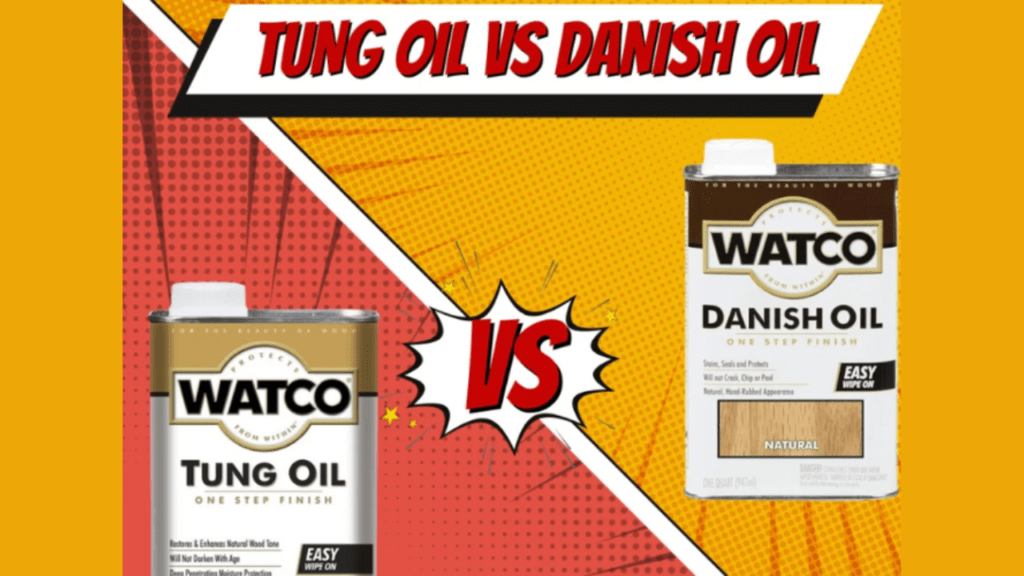
The oil you use when finishing wood will not only affect the appearance of the wood, but also can have a major impact on how it will look for years to come. There are two very favorite oils that you can use which are Tung and Danish oil. Both types have their plusses and minuses, but you should be able to tell them apart so that you can decide which is the most appropriate for your situation.
But what is the reality about the differences between them which one does a better job than the other and when you should use one over the other.Lets take a look at some of these key differences below. You’ll have a much clearer understanding of the right oil to use on your next woodworking project by the end.
What is Tung Oil ?
Tung oil (as well as China wood oil) is derived from the seeds of the Tung tree (Aleurites fordii) indigenous to China. And such oil has been applied already for a long time to protect and improving the wooden surface, especially in boats and the furniture’s.
And is valued for its penetrating character and resistance to water, stains and wear.
Key Features of Tung Oil:
Natural and Pure: Tung oil is a 100% natural, which makes it a great option for those who want a environmentally friendly products.
Water-Resistant: After it dries, the Tung oil forms a tough, water-resistant layer, which makes it perfect for both indoor and outdoor use.
Low Sheen Finish: It enhances the wood’s natural texture.
What is Danish Oil ?
Danish oil is a type of finishing oil made by mixing natural oils, like linseed oil, with varnish and sometimes solvents. This blend makes Danish oil more durable and versatile than pure Tung oil.
It is commonly used to give wood surfaces a soft matte finish, especially on furniture and cabinets.
Key Features of Danish Oil:
Blend of Oils and Varnish: Danish oil is a blend of different oils and varnish, resulting in a strong finish.
Versatile and Easy to Apply: Danish oil is very easy to use, making it a popular choice for both the beginners and among the experienced woodworkers.
Quick Drying: It dries significantly faster than Tung oil may save time during finishing.
Composition of Tung Oil vs Danish Oil
The differences in composition between Tung oil and Danish oil are easy to see.
Natural Ingredients in Tung Oil: This oil is made from just one ingredient — oil from the seeds of the Tung tree. It is fully natural, making it an eco-friendly choice for finishing wood.
Synthetic Ingredients in Danish Oil: Danish oil is a mix of natural oils (such as linseed and Tung oil) and synthetic resins or varnishes. This combination makes it more durable than the pure Tung oil, but it is less natural in comparison.
Key Differences Between Tung Oil and Danish Oil
Durability and Hardness:
Once fully cured, Tung oil creates a very hard and durable finish. It’s highly resistant to water, heat, and stains. Danish oil, while durable, doesn’t form as hard a surface as Tung oil. It provides a softer and more flexible finish.
Application and Finish:
Tung oil provides a matte, low-sheen finish that enhances the natural wood grain.. Danish oil, meanwhile, can often provide slightly glossy finish, adding a rich and warm look to the wood.
Drying Time and Curing Process:
Tung oil has a longer drying time and generally takes up to 2-3 weeks to cure. But Danish oil dries in just 24-48 hours although you may need to apply more coats.
Ease of Use:
Danish oil is easier to apply, especially for beginners. You can wipe it on with a rag and build up multiple coats easily. Tung oil requires more care during application, as it needs to be wiped off properly to avoid leaving sticky patches of excess oil.
Also read:
Teak Oil vs Tung Oil: Which Wood Finish is Best for You?
Wood Finishes 101: Make the Right Choice for your project !
Is Danish Oil Food Safe? Everything You Need to Know
Benefits of Tung Oil
Protects Against Water and Stains:
Tung oil forms a hard protective layer that seals the wood, keeping moisture and stains away. This makes it especially useful for furniture and outdoor items.
Enhances the Wood’s Natural Beauty:
This type of oil is known for bringing out the wood’s natural grain and color. It does not alter the natural beauty of the wood.
Benefits of Danish Oil
Provides a Soft, Matte Finish:
Danish oil gives a soft, matte finish that creates a natural look, ideal for those who prefer a more subtle shine on their wood projects.
Easy to Reapply and Maintain:
Danish oil is easy to maintain because you don’t need to strip it before reapplying. You can simply wipe on a new coat to refresh the finish.
Which Oil Should You Choose ?
Best Use Cases for Tung Oil
Outdoor Furniture: Tung oil is all weatherproof and perfect to be used outdoors.
Fine Woodworking Projects: If you prefer the natural grain of good wood, Tung oil is a best choice.
Best Use Cases for Danish Oil
Indoor Furniture: Danish oil is perfect for furniture that doesn’t face heavy exposure to water.
Quick Projects: When you want a quick drying time and easy applicability, Danish oil might be your best shot.
FAQs
1. Can You Use Tung Oil Outdoors?
Yes, Tung oil is highly resistant to water and can be used for outdoor furniture, decking, and even boats.
2. Is Danish Oil Food-Safe?
Danish oil is strong, but it might not be safe for food unless it says it is safe for kitchen use. Before using on food, always read the label.
3. How Do You Apply Each Oil?
Both oils are typically applied with a clean rag or brush. Tung oil may require more coats and more time to cure, while Danish oil dries faster and may require fewer coats.
4. How Long Does Each Oil Last?
Tung oil will be good for a number of years without reapplying. Danish oil while still durable, but may require re-application more regularly.
5. Can You Mix Tung Oil and Danish Oil?
Mixing Tung oil and Danish oil is not recommended, as their chemical compositions may not blend well. It’s better to choose one over the other for your project.
Conclusion
In summary, Tung oil and Danish oil have their advantages. But pure tung oil offers superior protection and the natural finish is ideal for quality work as well as outdoor use.
Danish oil, however, is easier to apply and maintain, making it a great choice for indoor furniture and quick projects. In the end, the right choice depends on your specific needs and preferences.

